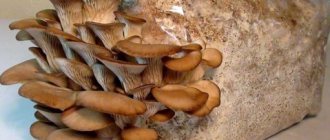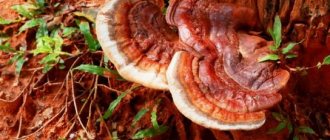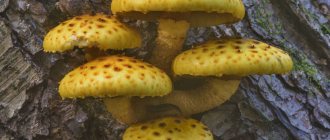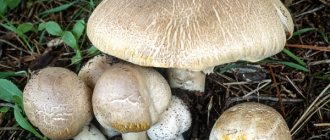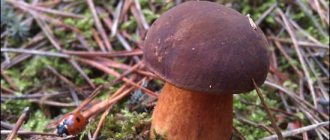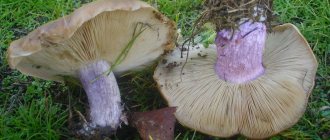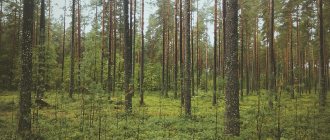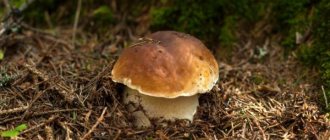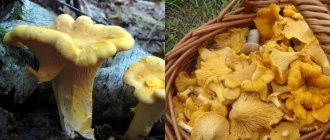Mushrooms that can be used as food without the risk of poisoning are called edible. There are many of them growing in natural conditions (forests, fields, meadows), they are in constant demand and popularity. But how many types of mushrooms do you know? There may be instances that you don't notice simply because you don't know them. If you want to expand your knowledge, read on.
Butter
The easiest way to grow butternuts is from ready-made forest mycelium. To do this, mark the place where a whole group of boletus has grown. Carefully cut off the top layer of soil by about 3 cm with a shovel and place it in an even layer in boxes.
Prepare a place for planting on your site. Butterflies prefer partial shade; they can be planted under young trees that will protect them from the bright sun.
Remove a layer of soil of the same shape and depth, deoxidize the soil well with ash or lime, add humus, place the soil with mycelium on the prepared area and water it generously. All mushrooms love moist soil. Therefore, when watering the area, do not forget about the mycelium.
After 2-3 years, when it has taken root well, boletus will begin to appear on the site, which are very rarely worm-like and grow up to 10 cm in diameter.
Aleuria orange
Orange aleuria (Aleuria aurantia) is found throughout the temperate zone: in deciduous and coniferous forests, parks. The mushroom grows on the soil along roadsides, on forest edges and lawns. Fruits from early summer to late autumn. The mushroom cap is bright orange in color and has the shape of a saucer with raised edges.
Orange aleuria is conditionally edible, has a neutral taste and contains vitamins B1, B2, PP, C. The mushroom is recommended to be eaten after heat treatment. You can add it to soups, decorate salads and meat dishes.
Champignon
Champignons grow well in the garden, in the shade of buildings and any secluded corners of the site. 3 weeks before planting, you need to prepare a special nutrient substrate for planting the mycelium. You can buy it at a specialty store or prepare it yourself.
To do this, you need to dig a trench approximately 30 cm deep. Add 5 parts of manure (it is better to use horse manure), 1 part of gypsum and lime, and 3 parts of straw. Mix everything, pour water well and cover with film.
After 3 weeks, the mycelium can be planted. You can also buy it or dig it up in the forest yourself. If everything is done correctly, the first harvest of champignons will appear this season.
You can also finely chop well-ripened mushrooms and scatter them over the substrate. However, then you will have to wait at least a year for the champignons to appear.
The influence of forest age and other conditions on the species diversity of fungi
Interestingly, mycorrhiza does not appear immediately, and fungal diversity directly depends on the age of the forest. The following stages can be distinguished:
- A young pine forest provides a little shade and a lot of sun, since the trees are still short, a thin layer of fallen pine needles, well-warmed earth, and little humidity. The first boletus - the pioneers of pine plantings - can appear in as little as 2 years.
- But after 15-20 years, the pine forest is already thick enough to provide dense shade, and the roots are still soft enough to allow the mycelium to “connect” to them for the exchange of substances. The layer of litter is still not so thick that it allows the soil to warm up enough for the rapid growth of mushroom bodies. This is the most favorable and generous period when it comes to the diversity and productivity of mushrooms. It lasts approximately 25 years: up to 40 years of age of the pines.
- After 40 years, the situation changes: the roots of pine trees become so hard that it is difficult for the mycelium to find a succulent place. And it’s cold now, the thick shadow from the crown does not allow the sun to pass through, the soil does not warm up, covered with old pine needles. The mycelium thins out, weakens, and partially dies. Harvests are declining. If suddenly for some reason the forest becomes thinner (hurricane, deforestation), and other tree species are sown there, then it can get a “second wind”, the microclimate inside will change, and new species of mushrooms will appear.
In addition to the age of the trees, which, of course, regulate the internal atmosphere in the forest, climate also matters. In dry years, the rate of mycorrhiza development is much slower. They contribute to changes and disasters, for example, strong winds that knock down trees.
You may be interested in:
Description and photos of edible mushrooms Mushroom pickers are not born, but become. You can master the complex science of edible and poisonous mushrooms at any age,...Read more...
White mushrooms
These most delicious mushrooms grow well on the site. There are several ways to plant them.
The first is ready-made mycelium. It is sold in specialized stores in bags of various packaging in the form of white dry granules.
The peculiarity of planting lies in a properly prepared trench with nutrient soil. You need to strictly follow the instructions on the packaging and remember that boletus mushrooms definitely need a shady place near fences, buildings and trees, as well as soil rich in humus, preferably in the form of rotted leaves.
The second method is much simpler, but gardeners claim that it is no less effective. It is necessary to remove the tubular green part under the cap, which contains spores, from a large, mature porcini mushroom. Fill it with 2 liters of water, add 20 g of yeast and 2 tsp. sugar, let them ferment for 1-2 weeks.
Then strain through a layer of gauze. Add the prepared infusion with spores to a watering can at the rate of 100 g per 10 liters of water and water it over the areas where you want to grow mushrooms.
Gardeners also recommend scattering old wormy mushrooms around the area under the trees. And then in a few years you will find mushroom plantations in these places.
First category
The porcini mushroom (boletus) is perhaps one of the most coveted trophies of mushroom pickers. Only white milk mushrooms stand in the same row with it. The cap of the boletus is convex, color from almost white to dark brown, dense to the touch. The bottom of the cap is light, greenish. With age it becomes green-yellow. The leg is barrel-shaped, thickened below, cream-colored with a pronounced mesh.
Boletus grows in almost all forests. Depending on the place of growth, it can form a symbiosis with birch, spruce, etc. Hence the variety of forms of this mushroom (spruce, birch, oak). There are about twenty of them in total.
Yellow milk mushroom is quite often found in coniferous forests with an admixture of birch. The cap of a young milk mushroom is flat and becomes funnel-shaped over time. The fringed edges are folded down and inward. Color from light yellow to yellow-ocher. The pulp is white, dense. The leg is white, straight, hollow inside.
Where do black and white truffles grow in Russia?
White milk mushroom also grows in mixed coniferous and birch forests. It occurs in large clusters, called piles, hence its name. The cap is slightly depressed, and over time takes the shape of a funnel. Its color is white, often with small yellow spots. The edges are shaggy and curved downwards. The pulp is strong, white. The cut produces a caustic milky juice that turns yellow in the air. White milk mushroom has a unique aroma and is highly valued for pickling.
Real camelina (pine) grows in the forests of the same name. Usually grows in large groups or colonies. The cap of the saffron milk cap is flat, and over time takes on a slightly depressed shape with the edges curved down and inward. Its color greatly depends on the place of growth and can vary from orange-red to dark pink. The flesh of the mushroom is dense and yellow. When cut, a milky juice of bright orange color is released.
There is also a spruce form. Spruce saffron milk cap is very fragile and does not tolerate transportation well. When scrapped and salted, it turns green. The taste is not inferior to its pine counterpart.
The real chanterelle grows in mixed forests, usually in large groups. It got its name because of the bright orange color characteristic of the animal of the same name. A young fox has a round, convex cap; over time, it stretches into an inverted cone with wavy, uneven edges. The pulp is fleshy, light yellow in color. The leg is narrowed downward.
Chanterelle is a natural antibiotic. It contains quinomannose, a unique substance harmless to humans that is not tolerated by helminths of all types. Thanks to him, chanterelles are never wormy. Eating chanterelles strengthens the immune system. In addition, this is the only mushroom that does not accumulate radionuclides.
boletus
The peculiarities of their cultivation are related to the fact that the mycelium is intertwined with the roots of the trees under which it grows, forming a symbiosis of two plants. The very name of the mushroom suggests that it prefers birch trees. If you have these trees on your property, this will be the best option.
You can plant them in different ways:
- Prepare an infusion with yeast and sugar from the lower tubular part of the mushroom and pour it in certain places, as with boletus mushrooms.
- Dig up and bring mycelium from the forest. However, this method is not always effective, since cutting and replanting correctly so that it takes root is not always possible. In addition, with this method there is always a chance of bringing poisonous toadstools or fly agarics along with the cultivated mycelium.
- Cut old mushrooms into pieces and scatter them or bury them at a shallow depth under trees.
Kalocera adhesive
Calocera viscosa is often called the horned plant because of the small “horns” on top. This unusual mushroom seems to glow from within, standing out as a bright yellow spot against the background of the forest floor. It is found in central Russia, Europe and North America, in coniferous and mixed forests.
The fruiting body of the mushroom is 2-8 cm high and has a sticky surface. The pulp is rubbery and gelatinous, with a neutral taste. The mushroom is edible and is considered a delicacy in some European countries. However, in Russia it is not popular due to its low taste, although it can be dried, boiled, fried, and used to decorate dishes.
Kalocera adhesive also has medicinal properties: polysaccharides extracted from the pulp of the mushroom stop the growth of sarcoma.
Boletus
The planting methods are the same as for boletus. However, you need to remember that they will grow best under aspen trees. Such a symbiosis will be most favorable for both plants. They also tolerate well the proximity to oak and birch trees.
When planting boletuses, it is important to remember that they prefer very wet, swampy areas. Therefore, it is better to sow them in lowlands and water them abundantly throughout the summer season.
Morels
These delicious mushrooms, which do not contain an ounce of toxins, love to live under apple trees. They can be grown in the country in two ways: French and German.
Using the German method, mature morel mushrooms should be cut into pieces and scattered under the apple trees.
It is good to cover with ash and water during the season. When the apples are ripe, do not remove the falling leaves and falling leaves. They will provide shelter and good feeding for mushrooms.
With the French method, a separate bed is made, on which pieces of mushrooms are also laid out. All season long, rotting fruits need to be thrown out, cleaned, and watered well. Cover with apple leaves for the winter.
Crested hedgehog
The comb mushroom (Hericium erinaceus) is often called lion's mane or mushroom noodle. This unusual mushroom grows on trees, stumps and is found in the Amur Region, Khabarovsk Territory, Primorsky Territory, northern China, the foothills of the Caucasus and the Crimea.
The combed hedgehog is an edible and very healthy mushroom. It tastes like shrimp or crab meat. In folk medicine, the mushroom is used to strengthen the immune system, treat chronic gastritis, cancer of the esophagus, stomach, leukemia, and also for recovery after strokes as a stimulator of growth and regeneration of nerve cell processes. Since the mushroom is listed in the Red Book, it is grown artificially, used in cooking in different countries, and also made from it as dietary supplements.
- Note: the medicinal properties of mushrooms – it works!
Did you know that many mushrooms are currently used as medicinal mushrooms?
We pass by some unusual mushrooms because we are not familiar with their properties. However, the world of mushrooms is so interesting that it is undoubtedly worth our attention.
Oyster mushrooms
These mushrooms are best grown in the basement or garage. You will need to purchase ready-made mycelium and prepare plastic bags with soil. Cereals, corn cobs, sunflower seeds or husks, and sawdust are suitable for the soil mixture.
There are several important points that must be observed:
- the soil for mushrooms must be poured with boiling water and left under pressure for at least 6 hours;
- You need 2 rooms where mushrooms will be grown: for germination and for ripening. Both of them must be treated with disinfectant solutions to kill pathogenic microbes;
- in bags, alternate a 15-20 cm layer of soil and mycelium. Fill the bags no more than 2/3 full and hang them on hooks. Make holes in the bags of at least 2 cm;
- during germination, the room temperature should be +23...+25°C, humidity – 95%. From the moment the first mushroom appears, the temperature should be kept within +12...+18°C and the room should be ventilated, illuminated with lamps for at least 12 hours a day.
- Author: Zimina Tatyana
Rate this article:
- 5
- 4
- 3
- 2
- 1
(0 votes, average: 0 out of 5)
Share with your friends!
